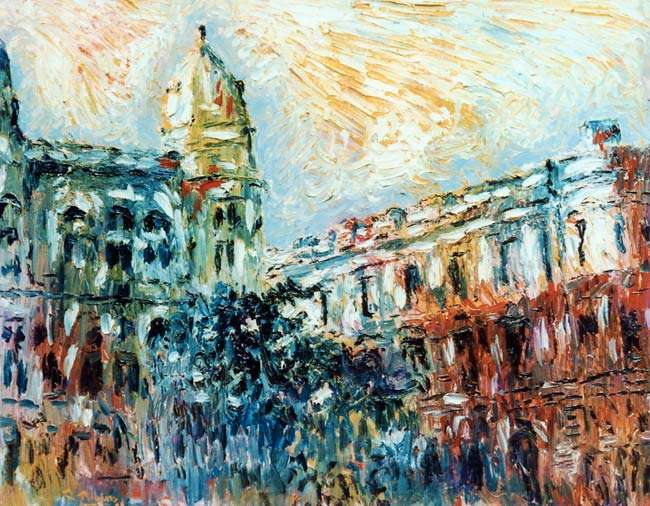Marcos Cordeiro
Recife Revisited
As he could not paint the streets blue, the major poet Carlos Pena Filho turned out, among others, one of the most beautiful sonnets in Portuguese - Soneto do Desmantelo Azul (Sonnet of the Blue Dismantlement). But, for his being as much a painter endowed with a refined sensibility as Carlos Pena is a poet, Plínio Palhano achieved what the latter did not: to paint blue not only buildings and streets, but the whole Recife. The ancient Recife of bohemians, poets and lovers has restored, for the new generations, the lost dignity of the old district which formerly was rich.
With the same strength of his penultimate phase, but with, say so, softer tonalities and colors, Plínio comes back, without surprise for all those who follow his present full-grown work - a "sensible" proposal, a poetical declaration of love for Recife, our Recife more of Pasargadae than the simple current "electioneering-tropical-anarchic-schmaltzy" hide-out.
Having roots in Expressionism, Plínio does not turn the outer aspect of the world into painting (contrary to the Impressionists). In pursuit of his "psychological landscapes of the Old Recife", his sensibility moves from the outside in, from the superficial to the spiritual. In his evocative origin, let us recompose in a realistic way the images represented. To give "expression" to his shapes, the artist makes use of a condensed coloring with different tones, usually with great dramatic force and expressive luminosity, in a process of structural fragmentation of the represented object owing to the discontinuity of the brushstrokes - dynamic and enraptured.
As a constant haunter, on Fridays and Saturdays, of the bars (OK, Califórnia, Chantecler, Moulin Rouge, Capitólio do Grego, Silver Star, etc.) in the Old Recife, with their jukeboxes, where we could listen to the likes of Orlando Silva, Dalva de Oliveira, Nelson Gonçalves, Agostinho dos Santos, Nora Ney and Núbia Lafayette, among others, in the far-gone 60s, together with my colleagues from the Casa do Estudante de Pernambuco (House of the Student of Pernambuco), these works, more than familiar, are psychological recomposition of sceneries of part of my idle and romantic youth. Longing for bygone days aside, but with lyric melancholy, to see these paintings and panels by Plínio is to revisit a Recife quite different from the present racked city. Of course, without ornamental shapes, but void of the democratized filthiness: misery and valueless rights. Looking at these pictures in their whole expressiveness, almost romantic, I cannot quit saying that, painstakenly, those façades, windows, buildings and streets formed part of the infrastructure of pleasure of that time. Of the simple and carefree pleasure of poor and hopeful academics (mostly from upstate Pernambuco and other northeastern states). I also cannot turn a deaf ear to these decayed shouting façades, as well as to the desperately happy wails and laughters washed down with beer and cuba libres (rum and coke) at Quitéria de Natal, Marinalva de Araripe, Maria-Quente, Toinha-Bote-Toda, Odete do Bago Mole among others, at the late nights along with my cousins Rafael, Manoel Afonso, Nicolau, Walter Lambreta, the friends Nilson Macena and Caop, the folks from São Bento do Una and many other colleagues who have gone for ever, such as Mário de Garanhuns, Edmilson de Belo Jardim and Zé Orlando de Petrolina.
In a less emotional view, after reading the paintings by Plínio Palhano, I may say that the abstract tonality of these works determines the distribution of spaces filled with tonal shades of great sentient intensity from the plastic relief of the brushstrokes: it shapes almost a sculptural volume, expressing the artist´s straight emotion in his process of art - with dynamism and ecstasy - aiming at an atmosphere more of bewitching than illusion, more of ideality than reality, because beyond time.
Olinda Oriental, October 1988.
Back to INSIDE RECIFE



